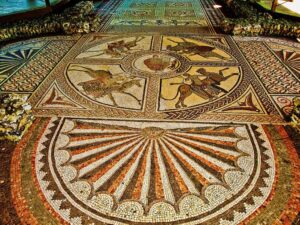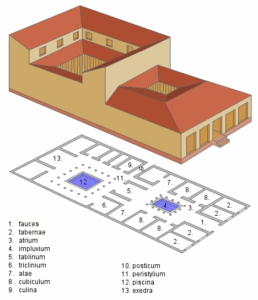Types of Roman Housing
Explore the various homes of ancient Rome and their structures
In ancient Rome, various types of housing existed, depending on the economic status of the inhabitants. The most common types included insulae, domus, and villas. Each type of home served different purposes and was constructed with varying materials and designs.
The insulae were primarily for the lower classes, while the domus catered to the wealthy. Villas served as country retreats for the elite. Understanding these housing types provides insight into the daily lives of Romans.
Insulae: The Apartment Blocks
 Insulae were multi-story apartment buildings that housed the lower and middle classes in urban areas. These structures were typically constructed from timber, mud brick, and primitive concrete. Insulae could reach heights of up to 20 meters and often contained several small apartments.
Insulae were multi-story apartment buildings that housed the lower and middle classes in urban areas. These structures were typically constructed from timber, mud brick, and primitive concrete. Insulae could reach heights of up to 20 meters and often contained several small apartments. The ground floor usually featured shops or taverns, while the upper floors housed living spaces. Rooms were often cramped and lacked basic amenities. Many insulae had no running water, forcing residents to rely on public fountains. The quality of construction was often poor, leading to frequent fires and collapses. Insulae represented the crowded living conditions of the urban poor, highlighting the stark contrast between different social classes in Rome.
Domus: The Wealthy Residence
The domus was the traditional house for wealthy Romans. These homes were larger and more elaborate than insulae. A typical domus featured an atrium, which was an open central space with a roof opening to collect rainwater. Surrounding the atrium were various rooms, including the tablinum, where the head of the household conducted business.
The domus often included a triclinium, or dining room, which was richly decorated to impress guests. Bedrooms, known as cubicula, were smaller and more private. The layout of the domus facilitated both domestic life and social interactions, serving as a space for family and business activities. The architecture of the domus reflected the wealth and status of its owner.
Villas: Country Retreats
Villas were large country houses that served as retreats for the wealthy elite. There were two main types of villas: the villa urbana and the villa rustica. The villa urbana was located near cities and used for leisure, while the villa rustica functioned as a working farm. Villas were often expansive, having gardens, baths, and various entertainment spaces.
They were designed to showcase wealth and included elaborate decorations such as mosaics and frescoes. The villa rustica was self-sufficient, providing agricultural produce and livestock. These estates played a significant role in the Roman economy, as they were centers for agricultural production and trade. Villas represented the lifestyle and social status of the Roman elite, serving both practical and recreational purposes.
Architectural Features and Decoration
 Roman housing had distinct architectural elements and decorations. The insulae were functional but lacked elaborate design.
Roman housing had distinct architectural elements and decorations. The insulae were functional but lacked elaborate design.
In contrast, the domus and villas were adorned with frescoes, mosaics, and marble decorations. The atrium of a domus often contained a small pool, known as an impluvium, to collect rainwater. The peristylium, an open courtyard, was a common feature in larger homes, providing a garden space. Wealthy Romans displayed their status through art and decoration, using sculptures and paintings to enhance their living spaces.
Roman Interior Decoration: Styles and Techniques

